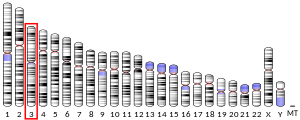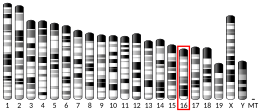Protein-coding gene in the species Homo sapiens
Ephrin type-B receptor 3 is a protein that in humans is encoded by the EPHB3 gene .[ 5] [ 6]
Function
Ephrin receptors and their ligands, the ephrins, mediate numerous developmental processes, particularly in the nervous system. Based on their structures and sequence relationships, ephrins are divided into the ephrin-A (EFNA) class, which are anchored to the membrane by a glycosylphosphatidylinositol linkage, and the ephrin-B (EFNB) class, which are transmembrane proteins. The Eph family of receptors are divided into 2 groups based on the similarity of their extracellular domain sequences and their affinities for binding ephrin-A and ephrin-B ligands. Ephrin receptors make up the largest subgroup of the receptor tyrosine kinase (RTK) family. The protein encoded by this gene is a receptor for ephrin-B family members.[ 6]
Interactions
EPHB3 has been shown to interact with MLLT4 [ 7] RAS p21 protein activator 1 .[ 8]
References
^ a b c GRCh38: Ensembl release 89: ENSG00000182580 – Ensembl , May 2017^ a b c GRCm38: Ensembl release 89: ENSMUSG00000005958 – Ensembl , May 2017^ "Human PubMed Reference:" . National Center for Biotechnology Information, U.S. National Library of Medicine .^ "Mouse PubMed Reference:" . National Center for Biotechnology Information, U.S. National Library of Medicine .^ Böhme B, Holtrich U, Wolf G, Luzius H, Grzeschik KH, Strebhardt K, Rübsamen-Waigmann H (Oct 1993). "PCR mediated detection of a new human receptor-tyrosine-kinase, HEK 2". Oncogene . 8 (10): 2857– 62. PMID 8397371 . ^ a b "Entrez Gene: EPHB3 EPH receptor B3" .^ Hock B, Böhme B, Karn T, Yamamoto T, Kaibuchi K, Holtrich U, Holland S, Pawson T, Rübsamen-Waigmann H, Strebhardt K (Aug 1998). "PDZ-domain-mediated interaction of the Eph-related receptor tyrosine kinase EphB3 and the ras-binding protein AF6 depends on the kinase activity of the receptor" . Proc. Natl. Acad. Sci. U.S.A. 95 (17): 9779– 84. Bibcode :1998PNAS...95.9779H . doi :10.1073/pnas.95.17.9779 PMC 21413 PMID 9707552 . ^ Hock B, Böhme B, Karn T, Feller S, Rübsamen-Waigmann H, Strebhardt K (Jul 1998). "Tyrosine-614, the major autophosphorylation site of the receptor tyrosine kinase HEK2, functions as multi-docking site for SH2-domain mediated interactions" . Oncogene . 17 (2): 255– 60. doi :10.1038/sj.onc.1201907 PMID 9674711 .
Further reading
Flanagan JG, Vanderhaeghen P (1998). "The ephrins and Eph receptors in neural development" (PDF) . Annu. Rev. Neurosci . 21 : 309– 45. doi :10.1146/annurev.neuro.21.1.309 . PMID 9530499 . S2CID 1278600 . Archived from the original (PDF) on 2019-02-21. Zhou R (1998). "The Eph family receptors and ligands". Pharmacol. Ther . 77 (3): 151– 81. doi :10.1016/S0163-7258(97)00112-5 . PMID 9576626 . Holder N, Klein R (1999). "Eph receptors and ephrins: effectors of morphogenesis". Development . 126 (10): 2033– 44. doi :10.1242/dev.126.10.2033 . PMID 10207129 . Wilkinson DG (2000). "Eph receptors and ephrins: regulators of guidance and assembly". Int. Rev. Cytol . International Review of Cytology. 196 : 177– 244. doi :10.1016/S0074-7696(00)96005-4 . ISBN 9780123646002 PMID 10730216 . Xu Q, Mellitzer G, Wilkinson DG (2001). "Roles of Eph receptors and ephrins in segmental patterning" . Philos. Trans. R. Soc. Lond. B Biol. Sci . 355 (1399): 993– 1002. doi :10.1098/rstb.2000.0635 . PMC 1692797 PMID 11128993 . Wilkinson DG (2001). "Multiple roles of EPH receptors and ephrins in neural development". Nat. Rev. Neurosci . 2 (3): 155– 64. doi :10.1038/35058515 . PMID 11256076 . S2CID 205014301 . Böhme B, VandenBos T, Cerretti DP, Park LS, Holtrich U, Rübsamen-Waigmann H, Strebhardt K (1996). "Cell-cell adhesion mediated by binding of membrane-anchored ligand LERK-2 to the EPH-related receptor human embryonal kinase 2 promotes tyrosine kinase activity" . J. Biol. Chem . 271 (40): 24747– 52. doi :10.1074/jbc.271.40.24747 PMID 8798744 . Ephnomenclaturecommittee (1997). "Unified nomenclature for Eph family receptors and their ligands, the ephrins. Eph Nomenclature Committee" . Cell . 90 (3): 403– 4. doi :10.1016/S0092-8674(00)80500-0 PMID 9267020 . S2CID 26773768 . Bergemann AD, Zhang L, Chiang MK, Brambilla R, Klein R, Flanagan JG (1998). "Ephrin-B3, a ligand for the receptor EphB3, expressed at the midline of the developing neural tube" . Oncogene . 16 (4): 471– 80. doi :10.1038/sj.onc.1201557 PMID 9484836 . Hock B, Böhme B, Karn T, Feller S, Rübsamen-Waigmann H, Strebhardt K (1998). "Tyrosine-614, the major autophosphorylation site of the receptor tyrosine kinase HEK2, functions as multi-docking site for SH2-domain mediated interactions" . Oncogene . 17 (2): 255– 60. doi :10.1038/sj.onc.1201907 PMID 9674711 . Hock B, Böhme B, Karn T, Yamamoto T, Kaibuchi K, Holtrich U, Holland S, Pawson T, Rübsamen-Waigmann H, Strebhardt K (1998). "PDZ-domain-mediated interaction of the Eph-related receptor tyrosine kinase EphB3 and the ras-binding protein AF6 depends on the kinase activity of the receptor" . Proc. Natl. Acad. Sci. U.S.A . 95 (17): 9779– 84. Bibcode :1998PNAS...95.9779H . doi :10.1073/pnas.95.17.9779 PMC 21413 PMID 9707552 . Ciossek T, Monschau B, Kremoser C, Löschinger J, Lang S, Müller BK, Bonhoeffer F, Drescher U (1998). "Eph receptor-ligand interactions are necessary for guidance of retinal ganglion cell axons in vitro". Eur. J. Neurosci . 10 (5): 1574– 80. doi :10.1046/j.1460-9568.1998.00180.x . PMID 9751130 . S2CID 20470923 . Adams RH, Wilkinson GA, Weiss C, Diella F, Gale NW, Deutsch U, Risau W, Klein R (1999). "Roles of ephrinB ligands and EphB receptors in cardiovascular development: demarcation of arterial/venous domains, vascular morphogenesis, and sprouting angiogenesis" . Genes Dev . 13 (3): 295– 306. doi :10.1101/gad.13.3.295 . PMC 316426 PMID 9990854 .
External links
Overview of all the structural information available in the PDB for UniProt : P54753 PDBe-KB .
Activity Regulation Classification Kinetics Types
Angiopoietin CNTF EGF (ErbB)
FGF
FGFR1 FGFR2
Agonists: Ersofermin FGF (1 , 2 (bFGF) , 3 , 4 , 5 , 6 , 7 (KGF ), 8 , 9 , 10 (KGF2) , 17 , 18 , 22 )Palifermin Repifermin Selpercatinib Sprifermin Trafermin FGFR3 FGFR4 Unsorted
HGF (c-Met) IGF
LNGF (p75NTR ) PDGF RET (GFL)
SCF (c-Kit) TGFβ Trk
TrkA
Negative allosteric modulators: VM-902A TrkB
Agonists: 3,7-DHF 3,7,8,2'-THF 4'-DMA-7,8-DHF 7,3'-DHF 7,8-DHF 7,8,2'-THF 7,8,3'-THF Amitriptyline BDNF BNN-20 Deoxygedunin Deprenyl Diosmetin DMAQ-B1 HIOC LM22A-4 N-Acetylserotonin NT-3 NT-4 Norwogonin (5,7,8-THF) R7 R13 TDP6 TrkC
VEGF Others
Additional growth factors: Adrenomedullin Colony-stimulating factors (see here instead)Connective tissue growth factor (CTGF) Ephrins (A1 , A2 , A3 , A4 , A5 , B1 , B2 , B3 )Erythropoietin (see here instead)Glucose-6-phosphate isomerase (GPI; PGI, PHI, AMF) Glia maturation factor (GMF) Hepatoma-derived growth factor (HDGF) Interleukins /T-cell growth factors (see here instead)Leukemia inhibitory factor (LIF) Macrophage-stimulating protein (MSP; HLP, HGFLP) Midkine (NEGF2) Migration-stimulating factor (MSF; PRG4) Oncomodulin Pituitary adenylate cyclase-activating peptide (PACAP) Pleiotrophin Renalase Thrombopoietin (see here instead)Wnt signaling proteins Additional growth factor receptor modulators: Cerebrolysin (neurotrophin mixture)
Information related to EPHB3





